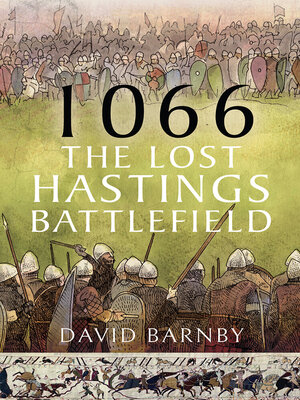
Sign up to save your library
With an OverDrive account, you can save your favorite libraries for at-a-glance information about availability. Find out more about OverDrive accounts.
Find this title in Libby, the library reading app by OverDrive.



Search for a digital library with this title
Title found at these libraries:
| Loading... |
A fully illustrated examination of the Battle of Hastings' historic accounts and analysis on the terrain and topography of the land.
The year 1066 is a date in English history that changed the way people lived and were governed, as well as transforming the language of the land. Astonishingly, this book finds the traditional site attracting many thousands of visitors each year is not where the battle was actually fought.
The death of King Edward the Confessor in January 1066 set off competing claims for the English throne by Norwegian King Harald Hardrada, Duke William of Normandy and the English magnate, Harold Godwinson; contentions finally settled at the epic Battle of Hastings later that year.
This book tells the compelling story, from the Norman duke's crossing with an army, that included a large cavalry contingent, in a fleet of Viking looking longboats from St Valery on the French coast, to the final battle, the Battle of Hastings, on Blackhorse Hill on the high ridge some two miles east of the traditional site at Battle Abbey. It was there that King Harold met his end when surrounded and attacked by Norman knights in the closing stages of the battle. In addition, the story from the Viking invasion of Lindisfarne until William’s crossing of the Channel and events leading up to William’s death have been included to provide context to our main story.
The sequence of events told here relies upon the several historic accounts and the placing of events, carefully matching them to the terrain described there with the topography of the area, a painstaking process of trial and error, to accurately place the battle site on Blackhorse Hill. The author has made use of satellite imagery, not previously available to earlier authors on the battle, to confirm the location of the old Cinque port of Hastings (first proposed by Nick Austin in his Secrets of the Norman Invasion), the site of Duke Williams's pre-battle camp. The author has analyzed the relative distances from the old port to the Battle Abbey site and the Blackhorse Hill site to eliminate the former and confirm the latter.
As far as is known, no-one has ever considered the Blackhorse Hill site before and it is hoped that this will inspire researchers to expand upon these findings.
The year 1066 is a date in English history that changed the way people lived and were governed, as well as transforming the language of the land. Astonishingly, this book finds the traditional site attracting many thousands of visitors each year is not where the battle was actually fought.
The death of King Edward the Confessor in January 1066 set off competing claims for the English throne by Norwegian King Harald Hardrada, Duke William of Normandy and the English magnate, Harold Godwinson; contentions finally settled at the epic Battle of Hastings later that year.
This book tells the compelling story, from the Norman duke's crossing with an army, that included a large cavalry contingent, in a fleet of Viking looking longboats from St Valery on the French coast, to the final battle, the Battle of Hastings, on Blackhorse Hill on the high ridge some two miles east of the traditional site at Battle Abbey. It was there that King Harold met his end when surrounded and attacked by Norman knights in the closing stages of the battle. In addition, the story from the Viking invasion of Lindisfarne until William’s crossing of the Channel and events leading up to William’s death have been included to provide context to our main story.
The sequence of events told here relies upon the several historic accounts and the placing of events, carefully matching them to the terrain described there with the topography of the area, a painstaking process of trial and error, to accurately place the battle site on Blackhorse Hill. The author has made use of satellite imagery, not previously available to earlier authors on the battle, to confirm the location of the old Cinque port of Hastings (first proposed by Nick Austin in his Secrets of the Norman Invasion), the site of Duke Williams's pre-battle camp. The author has analyzed the relative distances from the old port to the Battle Abbey site and the Blackhorse Hill site to eliminate the former and confirm the latter.
As far as is known, no-one has ever considered the Blackhorse Hill site before and it is hoped that this will inspire researchers to expand upon these findings.






